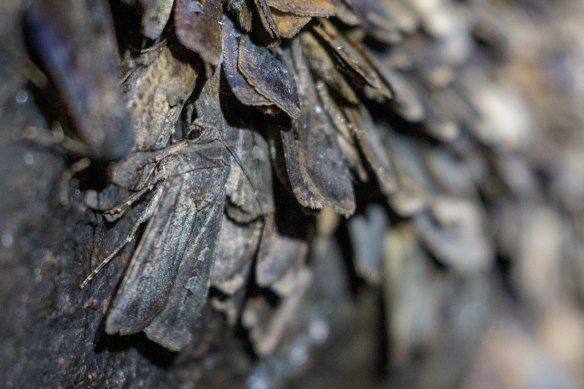
“Moth numbers atop Mount Gingera have been increasing over the past month, and are now at levels similar to before the severe 2017-2019 drought,” said Caley. “That it has taken three years of record-breaking rains for the moth numbers to recover [on Mount Gingera at least], speaks to how low the population must have fallen.”

A Bogong moth at Mount Gingera. Credit:ACF
At some Mount Gingera sites this year there were 17,000 moths per square metre, and Caley has estimated there were hundreds of thousands of individual moths on the mountain.
Professor Eric Warrant from Lund University, in Sweden, leads a team of researchers studying the Bogong moths in the Kosciuszko National Park. He was “cautiously optimistic” about moth numbers at Mount Selwyn.
“On two nights in November vast numbers were observed flying overhead and hundreds landed on our illuminated sheets,” he said.

Researchers taking photos of Bogong moths against a survey sheet with ultraviolet light.Credit:ACF
This summer was a pivotal moment for Bogong moths, according to Australian Conservation Foundation nature campaign Darcie Curruthers.
“The 2022 rebound should be a motivation to urgently act on climate change to ensure the species continues to thrive and play its vital role in Australia’s at-risk Alpine ecosystems,” Curruthers said.
First Nations people harvested the Bogong moth annually, a tradition that goes back at least 2000 years. It was a cultural occasion for ceremony and trade for Taungurung, Gunaikurnai and Woiwurrung people, according to Bijil Ba Wudhi Deberra: Bijil and Moths, the first book written for children in Taungurung and English.
Birds, mammals, lizards and frogs all rely on the annual influx of Bogong moths for an influx of summer protein. The critically endangered Mountain Pygmy-possum also relies on the moths to get through its breeding season.
For the past four years, the citizen science website Moth Tracker, established by Zoos Victoria and conservation partners, has been gathering data from Australians who log sightings of Bogong moths to help scientists track their location and migration patterns. This year it has had a record number of verified moth sightings.
Get to the heart of what’s happening with climate change and the environment. Our fortnightly Environment newsletter brings you the news, the issues and the solutions. Sign up here.









 Add Category
Add Category